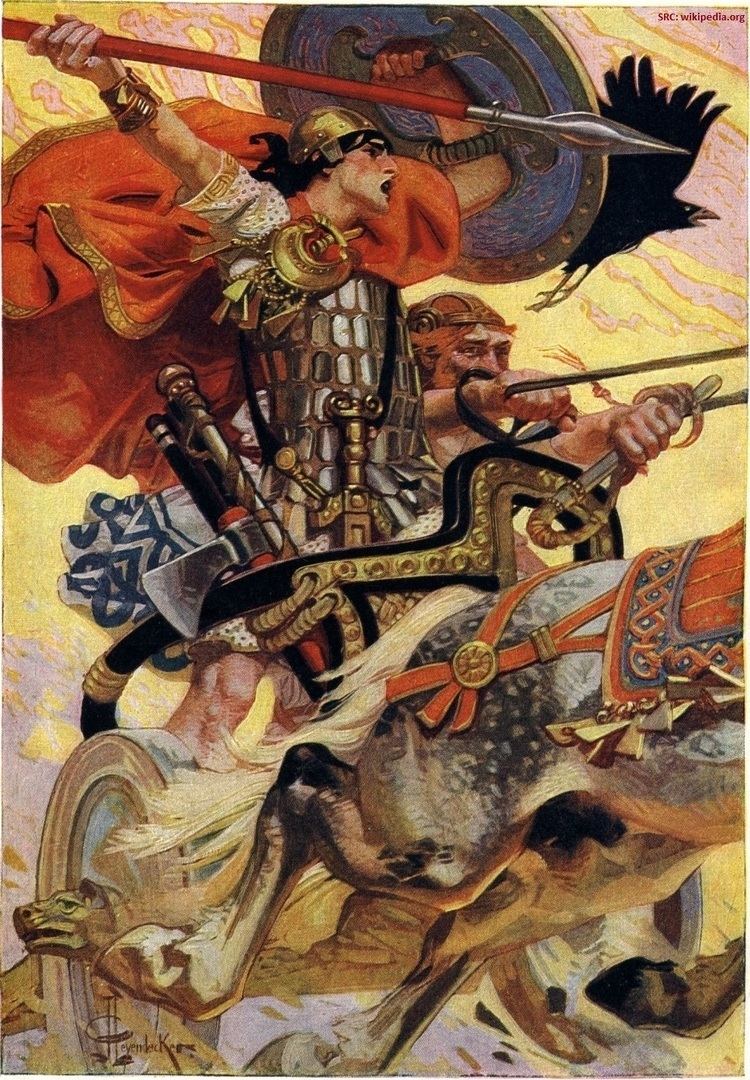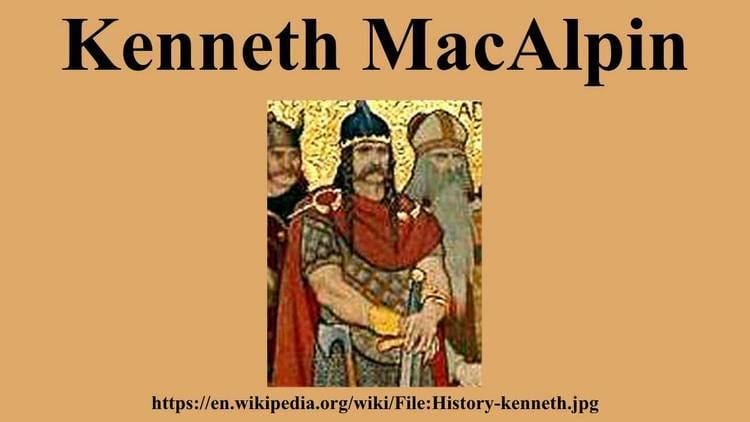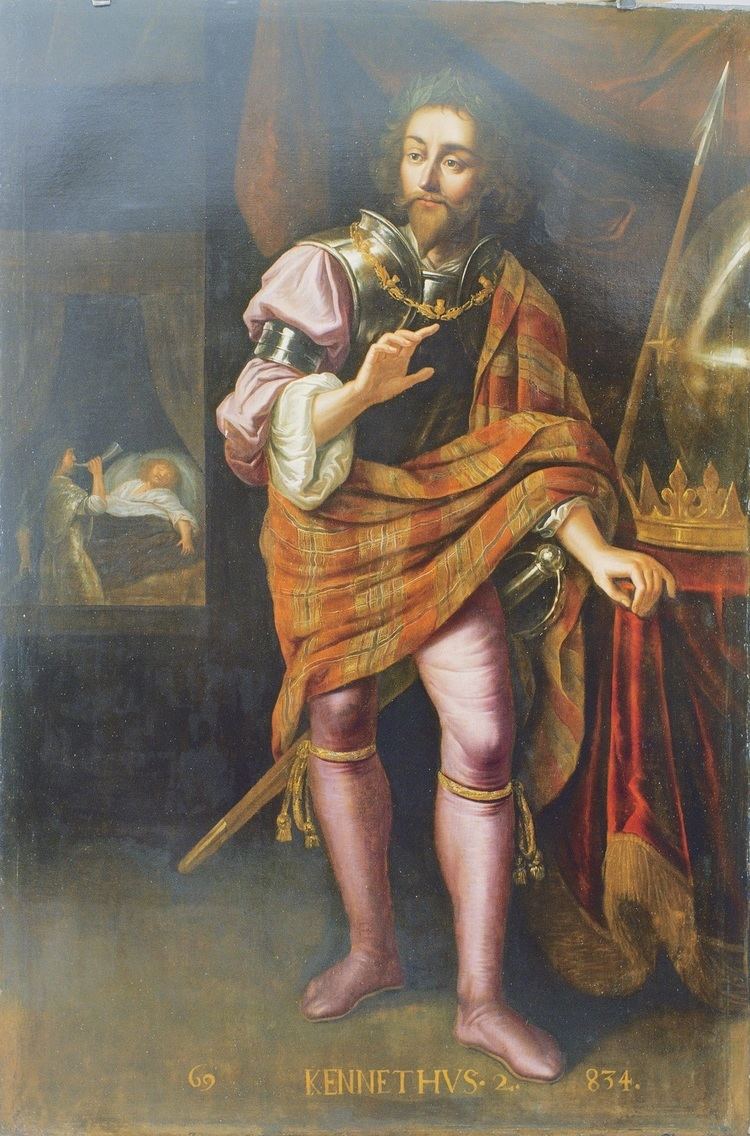Predecessor Monarchy established Name Kenneth MacAlpin Successor Donald I Siblings Domnall mac Ailpin | Burial Iona Nephews Giric House Alpin | |
 | ||
Reign 841 or 843 – 858 or 859 Issue
among possible others Constantin, King of the Picts
Aed, King of the Picts
Mael Muire Died February 13, 858 AD, Scotland, United Kingdom Children Causantin mac Cinaeda, Aed mac Cinaeda, Mael Muire ingen Cinaeda Grandchildren Donald II of Scotland, Constantine II of Scotland, Niall Glundub, Dyfnwal II of Strathclyde Similar People Malcolm II of Scotland, Kenneth II of Scotland, Duncan I of Scotland, Constantine II of Scotland, Kenneth III of Scotland | ||
Cináed mac Ailpin (Modern Gaelic: Coinneach mac Ailpein), commonly anglicised as Kenneth MacAlpin and known in most modern regnal lists as Kenneth I (810 – 13 February 858), was a king of the Picts who, according to national myth, was the first king of Scots. He was thus later known by the posthumous nickname of An Ferbasach, "The Conqueror". The dynasty that ruled Scotland for much of the medieval period claimed descent from him, and the current British monarch, Queen Elizabeth II is descended from him through Malcolm III, Robert the Bruce and James VI and I.
Contents

Kenneth macalpin
Disputed kingship

The Kenneth of myth, conqueror of the Picts and founder of the Kingdom of Alba, was born in the centuries after the real Kenneth died. In the reign of Kenneth II (Cináed mac Maíl Coluim), when the Chronicle of the Kings of Alba was compiled, the annalist wrote:

So Kinadius son of Alpinus, first of the Scots, ruled this Pictland prosperously for 16 years. Pictland was named after the Picts, whom, as we have said, Kinadius destroyed. ... Two years before he came to Pictland, he had received the kingdom of Dál Riata.

In the 15th century, Andrew of Wyntoun's Orygynale Cronykil of Scotland, a history in verse, added little to the account in the Chronicle:

Quhen Alpyne this kyng was dede, He left a sowne wes cal'd Kyned,
Dowchty man he wes and stout, All the Peychtis he put out.
Gret bataylis than dyd he, To pwt in freedom his cuntre!
When humanist scholar George Buchanan wrote his history Rerum Scoticarum Historia in the 1570s, a great deal of lurid detail had been added to the story. Buchanan included an account of how Kenneth's father had been murdered by the Picts and a detailed, and entirely unsupported, account of how Kenneth avenged him and conquered the Picts. Buchanan was not as credulous as many and he did not include the tale of MacAlpin's treason, a story from Gerald of Wales, who reused a tale of Saxon treachery at a feast in Geoffrey of Monmouth's inventive Historia Regum Britanniae.
Later 19th-century historians, such as William Forbes Skene, brought new standards of accuracy to early Scottish history, while Celticists, such as Whitley Stokes and Kuno Meyer, cast a critical eye over Welsh and Irish sources. As a result, much of the misleading and vivid detail was removed from the scholarly series of events, even if it remained in the popular accounts. Rather than a conquest of the Picts, instead, the idea of Pictish matrilineal succession, mentioned by Bede and apparently the only way to make sense of the list of Kings of the Picts found in the Pictish Chronicle, advanced the idea that Kenneth was a Gael, and a king of Dál Riata, who had inherited the throne of Pictland through a Pictish mother. Other Gaels, such as Caustantín and Óengus, the sons of Fergus, were identified among the Pictish king lists, as were Angles such as Talorcen son of Eanfrith, and Britons such as Bridei son of Beli.
Later historians would reject parts of the Kenneth produced by Skene and subsequent historians, while accepting others. Medievalist Alex Woolf, interviewed by The Scotsman in 2004, is quoted as saying:
The myth of Kenneth conquering the Picts – it’s about 1210, 1220 that that’s first talked about. There’s actually no hint at all that he was a Scot. ... If you look at contemporary sources there are four other Pictish kings after him. So he’s the fifth last of the Pictish kings rather than the first Scottish king."
Many other historians could be quoted in terms similar to Woolf.
A feasible synopsis of the emerging consensus may be put forward, namely, that the kingships of Gaels and Picts underwent a process of gradual fusion, starting with Kenneth, and rounded off in the reign of Constantine II. The Pictish institution of kingship provided the basis for merger with the Gaelic Alpin dynasty. The meeting of King Constantine and Bishop Cellach at the Hill of Belief near the (formerly Pictish) royal city of Scone in 906 cemented the rights and duties of Picts on an equal basis with those of Gaels (pariter cum Scottis). Hence the change in styling from King of the Picts to King of Alba. The legacy of Gaelic as the first national language of Scotland does not obscure the foundational process in the establishment of the Scottish kingdom of Alba.
Background
Kenneth's origins are uncertain, as are his ties, if any, to previous kings of the Picts or Dál Riata. Among the genealogies contained in the Rawlinson B 502 manuscript, dating from around 1130, is the supposed descent of Malcolm II of Scotland. Medieval genealogies are unreliable sources, but many historians still accept Kenneth's descent from the established Cenél nGabráin, or at the very least from some unknown minor sept of the Dál Riata. The manuscript provides the following ancestry for Kenneth:
...Cináed son of Alpín son of Eochaid son of Áed Find son of Domangart son of Domnall Brecc son of Eochaid Buide son of Áedán son of Gabrán son of Domangart son of Fergus Mór ...
Leaving aside the shadowy kings before Áedán son of Gabrán, the genealogy is certainly flawed insofar as Áed Find, who died c. 778, could not reasonably be the son of Domangart, who was killed c. 673. The conventional account would insert two generations between Áed Find and Domangart: Eochaid mac Echdach, father of Áed Find, who died c. 733, and his father Eochaid.
Although later traditions provided details of his reign and death, Kenneth's father Alpin is not listed as among the kings in the Duan Albanach, which provides the following sequence of kings leading up to Kenneth:
It is supposed that these kings are the Constantine son of Fergus and his brother Óengus II (Angus II), who have already been mentioned, Óengus's son Uen (Eóganán), as well as the obscure Áed mac Boanta, but this sequence is considered doubtful if the list is intended to represent kings of Dál Riata, as it should if Kenneth were king there.
That Kenneth was a Gael is not widely rejected, but modern historiography distinguishes between Kenneth as a Gael by culture and/or in ancestry, and Kenneth as a king of Gaelic Dál Riata. Kings of the Picts before him, from Bridei son of Der-Ilei, his brother Nechtan as well as Óengus I son of Fergus and his presumed descendants were all at least partly Gaelicised. The idea that the Gaelic names of Pictish kings in Irish annals represented translations of Pictish ones was challenged by the discovery of the inscription Custantin filius Fircus(sa), the latinised name of the Pictish king Caustantín son of Fergus, on the Dupplin Cross.
Other evidence, such as that furnished by place-names, suggests the spread of Gaelic culture through western Pictland in the centuries before Kenneth. For example, Atholl, a name used in the Annals of Ulster for the year 739, has been thought to be "New Ireland", and Argyll derives from Oir-Ghàidheal, the land of the "eastern Gaels".
Reign
Compared with the many questions on his origins, Kenneth's ascent to power and subsequent reign can be dealt with simply. Kenneth's rise can be placed in the context of the recent end of the previous dynasty, which had dominated Fortriu for two or four generations. This followed the death of king Uen son of Óengus of Fortriu, his brother Bran, Áed mac Boanta "and others almost innumerable" in battle against the Vikings in 839. The resulting succession crisis seems, if the Pictish Chronicle king-lists have any validity, to have resulted in at least four would-be kings warring for supreme power.
Kenneth's reign is dated from 843, but it was probably not until 848 that he defeated the last of his rivals for power. The Pictish Chronicle claims that he was king in Dál Riata for two years before becoming Pictish king in 843, but this is not generally accepted. It is also said that his reign began in 834 and ended in 863, this is especially predominant in the 17th and 18th centuries where many depictions of Kenneth would state his reign as either 834-863 or 843-863. In 849, Kenneth had relics of Columba, which may have included the Monymusk Reliquary, transferred from Iona to Dunkeld. Other than these bare facts, the Chronicle of the Kings of Alba reports that he invaded Saxonia six times, captured Melrose and burnt Dunbar, and also that Vikings laid waste to Pictland, reaching far into the interior. The Annals of the Four Masters, not generally a good source on Scottish matters, do make mention of Kenneth, although what should be made of the report is unclear:
Gofraid mac Fergusa, chief of Airgíalla, went to Alba, to strengthen the Dal Riata, at the request of Kenneth MacAlpin.
The reign of Kenneth also saw an increased degree of Norse settlement in the outlying areas of modern Scotland. Shetland, Orkney, Caithness, Sutherland, the Western Isles and the Isle of Man, and part of Ross were settled; the links between Kenneth's kingdom and Ireland were weakened, those with southern England and the continent almost broken. In the face of this, Kenneth and his successors were forced to consolidate their position in their kingdom, and the union between the Picts and the Gaels, already progressing for several centuries, began to strengthen. By the time of Donald II, the kings would be called kings neither of the Gaels or the Scots but of Alba.
Kenneth died from a tumour on 13 February 858 at the palace of Cinnbelachoir, perhaps near Scone. The annals report the death as that of the "king of the Picts", not the "king of Alba". The title "king of Alba" is not used until the time of Kenneth's grandsons, Donald II (Domnall mac Causantín) and Constantine II (Constantín mac Áeda). The Fragmentary Annals of Ireland quote a verse lamenting Kenneth's death:
Because Cináed with many troops lives no longer
there is weeping in every house;
there is no king of his worth under heaven
as far as the borders of Rome.
Kenneth left at least two sons, Constantine and Áed, who were later kings, and at least two daughters. One daughter married Run, king of Strathclyde, Eochaid being the result of this marriage. Kenneth's daughter Máel Muire married two important Irish kings of the Uí Néill. Her first husband was Aed Finliath of the Cenél nEógain. Niall Glúndub, ancestor of the O'Neill, was the son of this marriage. Her second husband was Flann Sinna of Clann Cholmáin. As the wife and mother of kings, when Máel Muire died in 913, her death was reported by the Annals of Ulster, an unusual thing for the male-centred chronicles of the age.
